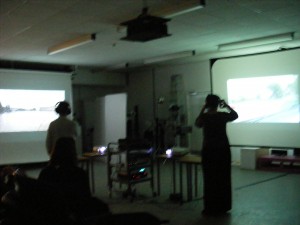Over and Under Water – Over and Under Ground
February 2012
Earlier in 2012 I set up, at Oxford Brookes University, an installation in a studio showing two films. I was interested to see if the films would draw attention to our own usually subconscious reading of time, sound and distance, and if the combination of hearing the sound from the two films would emphasise this.

Two screens
The DVDs used a 5.1 sound system to enable the two soundtracks.
One film was shot in Bristol docks and one in a street in Oxford. These two looped digital recordings each had two soundtracks recorded in those places: in Bristol above and below water and in Oxford above and below ground.

The screen showing Bristol Docks
If you chose to look at the docks scene (a view of Bristol Docks) you could either hear the sound above the water or the sound below the water on head phones. The sound from the boats could be heard on the hydrophone under water as well as above the water.
Try each ear separately on the headphones to compare sound
[audio:https://shirleypegna.com/wp-content/uploads/2012/08/boat-in-docks.mp3|titles=boat in docks]

Equipment on pontoon
I used a hydrophone for the under water recordings and a long-range stereo rifle mic recording into a Fostex digital recorder. The hydrophone is about 1.5m depth off the end of the pontoon .
If you chose to look at the road scene (a road outside Oxford) you could hear the sound above the road or sounds under the road in the ground.

Screen showing street scene and pedestrian
When you heard the footsteps on the path and saw the person making them,
the sound of the impact of the step of the walkers below the ground (or cars or bikes), contrasted with those picked up on the mics above ground, due to the different speeds at which sound travels through ground and air.
Try each ear separately on the headphones to compare sound
[audio:https://shirleypegna.com/wp-content/uploads/2012/08/street-scene.mp3|titles=street scene]
I used a pair mics (Rode NTG2) recording the over ground sound into an Edirol 44 digital recorder, and for the under ground sounds I ran the a geophone – SM24 -into a battery operated sound system in my car and recorded from another digital recorder from the subwoofer. To boost the geophones signal I had a preamp and 3000W car amp and 15” sub.

Equipment to amplify sound from the ground
At the front of the car, not shown here, was a pair of mics recording over ground sounds by the front wing mirrors.
Below is the scene from the end of the docks, when I made the recording, where I could hear the diesel engines of the different boats before they rounded the corner into view. I wondered if I could show this and the viewer would understand that the sound in the water was travelling faster than the sound in the air.

Recording on the docks
At the time, and for both films, there were practical difficulties cueing the equipment to sync up the sound and film, getting permissions from the public when they came into shot and getting good sound levels. All of which led me to think that this would be a work in progress exercise rather than a finished product.
I had feedback from the discussion group:
• ‘…intrigued at the under ground sounds…’
• ‘…surprised at the high frequency of the under water sounds.’
• ‘I was distracted by trying to work out where the mics were recording the sounds.’
• Would you film the hydrophone and geophone? Would you film the cameras filming the shot to showing where different sounds were coming from?
• ‘Sounds heard beyond the visual field (of the film) were confusing.’
Trying to narrow the shot and the view of the source of the sound, did not allow
the listener to understand where the mics were picking up the sound.
• ‘The films are so different: one panoramic and one almost domestic.’
On the whole the viewers trying to compare sounds and distances found the
two scenes and techniques offered a complex set of visual information.
• ‘The camera on the tripod is totally different to the hand held one, where there is a different narrative.’
• ‘The two films needed to be presented together to get the contrast and only one film would be less than half of the presentation.’
• ‘Having a close up of the water’, and ‘ a shot of the geophone down a hole,’
it was suggested, would ‘help to give an impression of sound coming from under
water and under ground’.
Earlier on decisions were made about the presentation of the sounds the themselves, and ideas like putting them on speakers placed up high and down low, and only having the ‘under’ sounds on headphones – were tested. The whole exercise did generate ideas about how to direct listeners to listen to specific sounds.

Viewer listening with two pairs of headphones
Filming and recording where time, sound and distance are key showed me some of the complexities of trying to portray the idea of ‘seeing sound’. Elements of the ideas for this presentation informed me about subsequent work and particularly isolating ways of listening to and through water in a more domestic environment.
This film by Kaffe Mathews (see vimeo) shows another way of focusing on the under water world and its’ sounds. It was made in collaboration with Nenagh Watson on a theme of Ephemeral Animation.
http://expandedanimation.myblog.arts.ac.uk/2012/03/11/ephemeral-animation-nenagh-watson/
Speed of sound in AIR (depending on air quality)
344mp/s
Speed of sound in GROUND (depending on ground type)
5,000 – 13,000 mp/s
Speed of sound in WATER (depending on water type)
1482 mp/s
http://www.wolframalpha.com/input/?i=speed+of+sound+in+water
http://askville.amazon.com/sound-travel-faster-air-ground/AnswerViewer.do?requestId=3760983

End